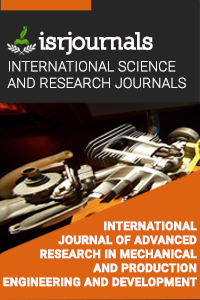numerical simulation of high mach number flow using the finite difference lattice boltzmann method fdlbm
sadatsakkak,
Published in International Journal of Advanced Research in Mechanical and Production Engineering and Development
ISSN: 2320-7256 Impact Factor:1.398 Volume:1 Issue:3 Year: 05 July,2016 Pages:196-208

Abstract
The lattice Boltzmann method (LBM) is a powerful numerical tool for simulating fluid flows. In particular, it has demonstrated a unique capability for handling incompressible flows in complex geometries and multi-component flows. Much effort has been expended to extend the LBM to deal with compressible thermal fluids. Lattice Boltzmann (LB) modeling compressible flows has long been attempted by various researchers. One common weakness of most of previous models is the instability problem when the Mach number of the flow is large. In this paper we present a finite-difference LB model, which works for flows with any ratios of specific heats and a wide range of Mach number, from 0 to 30 or higher. To correctly represent compressibility in a thermal fluid, multiple particle speeds have to be introduced. Besides the discrete-velocity-model by Watari, a modified Lax–Wendroff finite difference scheme and an artificial viscosity are introduced. The combination of the finite-difference scheme and the adding of artificial viscosity must find a balance of numerical stability versus accuracy. The proposed model is validated by recovering results of some well-known benchmark tests: shock tubes (one dimensional), supersonic bump and ramp (two dimensional). The two sets of results have a satisfying agreement with exact solutions.
Kewords
: Lattice Boltzmann Method, Finite Difference, High Mach Number flow
Reference
S. Succi, The Lattice Boltzmann Equation for Fluid Dy namics and Beyond, Oxford University Press, New York (2001). [1] A.G. Xu, X.F. Pan, G.C. Zhang, and J.S. Zhu, J. Phys.: Condens. Matter 19 (2007) 326212; J. Phys. D: Appl. Phys. 41 (2008) 015401; X.F. Pan, A.G. Xu, G.C. Zhang [2] Q.F. Wu, W.F. Chen, DSMC Method for Heat Chemical Nonequilibrium Flow of High Temperature Rarefied Gas, National Defence Scienceand Technology University Press, Beijing, 1999 (in Chinese). [3] G. McNamara, B. Alder, Physica A 194 (1993) 218. [4] F.J. Alexander, S. Chen, J.D. Sterling, Phys. Rev. E 47 (1993) R2249. [5] N. Cao, S. Chen, S. Jin, D. Martinez, Phys. Rev. E 55 (1997) R21. [6] Gangwu Yan, Yaosong Chen, Shouxin Hu, Phys. Rev. E 59 (1999) 454. [7] H. Yu and K. Zhao, Phys. Rev. E 61 (2000) 3867. [8] C. Sun, Phys. Rev. E 58 (1998) 7283. [9] C. Sun, Phys. Rev. E 61 (2000) 2645. [10] C. Sun and A.T. Hsu, Phys. Rev. E 68 (2003) 016303. [11] T. Kataoka and M. Tsutahara, Phys. Rev. E 69 (2004) 035701(R); Phys. Rev. E 69 (2004) 056702. [12] ]M. Watari and M. Tsutahara, Phys. Rev. E 67 (2003) 036306; Phys. Rev. E 70 (2004) 016703. [13] A.G. Xu, Europhys. Lett. 69 (2005) 214; Phys. Rev. E 71 (2005) 066706; Prog. Theor. Phys. (Suppl.) 162 (2006) 197. [14] M. Watari, M. Tsutahara, Phys. Rev. E 67 (2003) 036306; Phys. Rev. E 70 (2004) 016703. [15] Aiguo Xu, Europhys. Lett. 69 (2005) 214; Phys. Rev. E 71 (2005) 066706; Prog. Theor. Phys. (Suppl.) 162 (2006) 197. [16] R. Benzi, S. Succi, M. Vergassola, Phys. Rep. 222 (1992) 145; [17] W.A. Yong, L.S. Luo, Phys. Rev. E. 67 (2003) 1063. [18] A. Xiong, Acta Mech. Sinica (English Series) 18 (2002) 603. [19] F. Tosi, S. Ubertini, S. Succi, H. Chen, I.V. Karlin, Math. Comput. Simul. 72 (2006) 227. [20] S. Ansumali, I.V. Karlin, J. Stat. Phys. 107 (2002) 291 [21] Y. Li, R. Shock, R. Zhang, H. Chen, J. Fluid Mech. 519 (2004) 273. [22] V. Sofonea, A. Lamura, G. Gonnella, A. Cristea, Phys. Rev. E 70 (2004) 046702. [23] R.A. Brownlee, A.N. Gorban, J. Levesley, Phys. Rev. E 75 (2007) 036711 [24]

